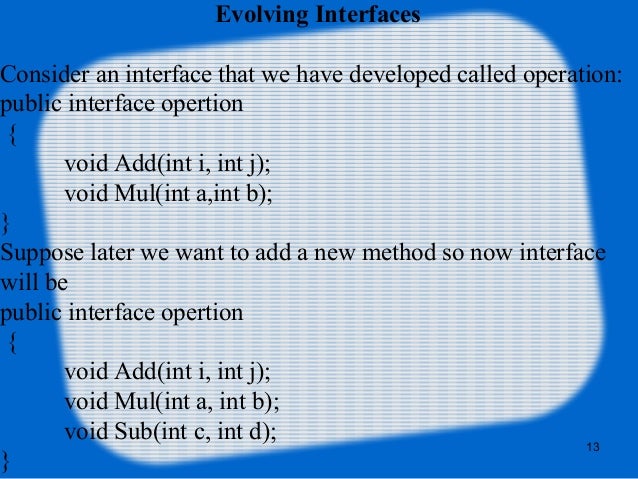
The following is the syntax for declaring an interface. For example, if an interface has four methods, and a class implements only three methods, then the class must be declared as abstract. In other words, they cannot be changed by the implementing class.Ī class that implements an interface is required to provide implementations for all the methods of the interface or else should be declared abstract. When an interface is implemented by a class, all the variables of the interface will act as constant variables for the class. It can be implemented by other classes or extended by other interfaces. Abstraction is a process where you show only relevant data and hide unnecessary details of an object from the user(See: Abstraction).
#Java interface rules full#
Unlike abstract class an interface is used for full abstraction.

Implementing InterfacesĪn interface in Java is defined as a reference type and is similar to a class except that it has only final and static variables, abstract method signatures. In the last tutorial we discussed abstract class which is used for achieving partial abstraction. A Java source file is described as being in Google Style if and only if it adheres to the rules herein.
#Java interface rules code#
This can act similar to multiple inheritance. This document serves as the complete definition of Googles coding standards for source code in the Java Programming Language. Result: This is Address of Crunchify Company.Note: Though Java does not support multiple inheritance, interfaces provide a workaround by allowing classes to implement one or more interfaces in addition to inheriting a class. Super.address() // invokes the super class method When invoking a superclass version of an overridden method the super keyword is used. Then at the runtime it runs the method specific for that object. Therefore in the above example, the program will compile properly since Company class has the method move. However in the runtime JVM figures out the object type and would run the method that belongs to that particular object. In general, we will actually prefer the use of interfaces in client code (prefer List to ArrayList, for instance). Reason: In compile time the check is made on the reference type. In the above example you can see that the even though b is a type of Company it runs the move method in the eBay class. } Result: This is Address of Crunchify Company. ("This is Address of Crunchify Company.") Sample Example: package Ĭompany a = new Company() // Company reference and objectĬompany b = new eBay() // Company reference but eBay objectĪ.address() // runs the method in Company classī.address() // Runs the method in eBay class The overriding method can throw narrower or fewer exceptions than the overridden method. However the overriding method should not throw checked exceptions that are new or broader than the ones declared by the overridden method.An overriding method can throw any uncheck exceptions, regardless of whether the overridden method throws exceptions or not.A subclass in a different package can only override the non-final methods declared public or protected. The functional Consumer interface is used extensively across the Java API, with a number of classes in the package, such as ObjIntConsumer, BIConsumer and IntConsumer providing extended support to the basic interface.


The access level cannot be more restrictive than the overridden method’s access level.This means that classes implementing an interface must define the methods with public visibility (in line with the normal rule that a method cannot be overridden with. The return type should be the same or a subtype of the return type declared in the original overridden method in the super class. In Java 8 all members of interfaces (and interfaces themselves) are assumed to be public, and cannot be protected or private (but Java 9 does allow private methods in interfaces).The argument list should be exactly the same as that of the overridden method.In java, a method can only be written in Subclass, not in same class.Last week I wrote Java Method Hiding and Overriding: Override Static Method in Java here.īut I realized, it’s worth sharing some more information on Java Method Overriding. Rules for Declaring Nested Interface Nested interfaces are implicitly static regardless of where they are declared (inside class or another interface).


 0 kommentar(er)
0 kommentar(er)
